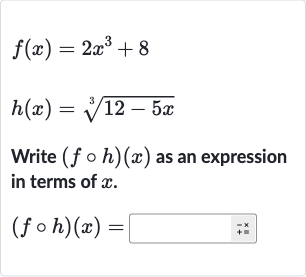AI tutor
Full solution
Q. Write as an expression in terms of .
- Substitute into : To find the composition of the functions , we need to substitute the function into the function . This means we will replace every instance of in with .
- Write down : First, let's write down the function : . This is the cube root of .
- Write down : Now, let's write down the function : .
- Cube root of : Substitute into to get : .
- Replace cubed : Now we need to cube the expression for : . When we cube a cube root, they cancel each other out, so we are left with the expression inside the cube root, which is .
- Simplify the expression: Replace the cubed in the expression for : .
- Multiply through the expression: Now we simplify the expression: .
- Combine like terms: Multiply through the expression: .
- Final expression: Combine like terms to get the final expression for : .
More problems from Compare linear and exponential growth
QuestionGet tutor help
QuestionGet tutor help
QuestionGet tutor help
QuestionGet tutor help
QuestionGet tutor help
QuestionGet tutor help
QuestionGet tutor help

